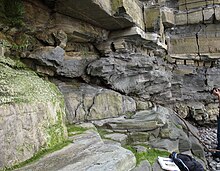Vertical displacement
In
Tectonic causes of vertical displacement

Vertical displacement resulting from tectonic activity occurs at divergent and convergent plate boundaries. The movement of magma in the asthenosphere can create divergent plate boundaries as the magma begins to rise and protrude weaker lithospheric crust. Subsidence at a divergent plate boundary is a form of vertical displacement which occurs when a plate begins to split apart.[2] As intrusive magma widens the rift zone of a divergent plate boundary the layers of crust on the surface above the rift will subside into the rift, creating a vertical displacement of those layers of surface crust.[2]
Convergent plate boundaries create orogenies such as the Laramide orogeny that raised the Rocky Mountains.[3] For this orogen event dense oceanic crust from the Pacific plate subducts beneath the less dense continental crust of the North American plate as they converge. This subduction induced the compression of the bounded western region of the North American plate which created the uplift of different layers of rock. This vertical displacement created the various mountain formations which are cumulatively known as the Rocky Mountain range.[3]
Earthquakes are one mechanism that leads to vertical displacement of crust. The fracturing of land during an earthquake creates a fault when land is displaced during the event.[4] The throw of the fault is a term used to describe and quantify the magnitude of this displacement.
Glacial isostatic adjustment

Changes in
Using asthenosphere viscosity data researchers are able to determine the rate by which isostatic rebound occurs. Isostatic rebound occurrence rate can be determined by comparing local viscosities to the maximum viscosity of the asthenosphere. Areas with higher viscosity are subject to quick isostatic rebound while in regions of low viscosity crustal uplift occurs at a slower rate. Uplift is still occurring through isostatic rebound from the Last Glacial Maximum.[6]
Glacial isostatic rebound leads to sea level regression which can be measured using 14C dating to determine the age of sublittoral sediment in different regions along the seafloor.[5]
See also
- Ground displacement
Notes
- ^ ISBN 9781444345032.)
{{cite book}}: CS1 maint: multiple names: authors list (link - ^ S2CID 53476061.
- ^ ISBN 978-0-87842-216-6.)
{{cite book}}: CS1 maint: multiple names: authors list (link - ^ Rafferty, John P., (2013). "Geological Sciences". New York, NY: Rosen Publishing Group. 9781615305445. https://www.vitalsource.com/sa/en-us/products/geological-sciences-britannica-educational-v9781615305445
- ^ doi:10.1016/S0277-3791(01)00006-3.)
{{cite journal}}: CS1 maint: multiple names: authors list (link - ISSN 1944-9208.
